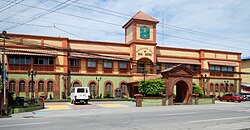San Isidro, officially the Municipality of San Isidro (Tagalog: Bayan ni San Isidro, Kapampangan: Balen ning San Isidro), is a 2nd class municipality in the provinceofNueva Ecija, Philippines. According to the 2020 census, it has a population of 54,372 people.[3]
San Isidro
| |
|---|---|
| Municipality of San Isidro | |

Municipal hall
| |

Map of Nueva Ecija with San Isidro highlighted
| |
OpenStreetMap | |
|
Location within the Philippines | |
| Coordinates: 15°18′35″N 120°54′25″E / 15.3097°N 120.9069°E / 15.3097; 120.9069 | |
| Country | Philippines |
| Region | Central Luzon |
| Province | Nueva Ecija |
| District | 4th district |
| Barangays | 9 (see Barangays) |
| Government | |
| • Type | Sangguniang Bayan |
| • Mayor | Florentino C. Tinio |
| • Vice Mayor | John Carlo A. Patiag |
| • Representative | Emerson D. Pascual |
| • Municipal Council | Members
|
| • Electorate | 33,813 voters (2022) |
| Area | |
| • Total | 56.49 km2 (21.81 sq mi) |
| Elevation | 21 m (69 ft) |
| Highest elevation | 35 m (115 ft) |
| Lowest elevation | 12 m (39 ft) |
| Population
(2020 census)[3]
| |
| • Total | 54,372 |
| • Density | 960/km2 (2,500/sq mi) |
| • Households | 12,828 |
| Economy | |
| • Income class | 2nd municipal income class |
| • Poverty incidence |
|
| • Revenue | ₱ 181.6 million (2020) |
| • Assets | ₱ 568.2 million (2020) |
| • Expenditure | ₱ 173.5 million (2020) |
| • Liabilities | ₱ 282.2 million (2020) |
| Service provider | |
| • Electricity | Nueva Ecija 1 Electric Cooperative (NEECO 1) |
| Time zone | UTC+8 (PST) |
| ZIP code |
3106
|
| PSGC | |
| IDD : area code | +63 (0)44 |
| Native languages | Kapampangan Tagalog Ilocano |
The municipality is bounded by Gapan to the east, the municipalities of San Leonardo and Jaen to the north, San Antonio to the west, Cabiao to the south-west, San Miguel, Bulacan, to the southeast and Candaba, Pampanga, to the south. It is 29 kilometres (18 mi) from Cabanatuan, 43 kilometres (27 mi) from Palayan, and 99 kilometres (62 mi) from Manila.
San Isidro became the capital of the Philippines during the First Republic while President Emilio Aguinaldo was moving north to avoid being captured by American forces.
San Isidro was the capital of Nueva Ecija from 1852 to 1912.[5] San Isidro, along with its origin Gapan, Aliaga, Cabiao, and San Antonio were transferred from Pampanga to Nueva Ecija in 1848. After the first cry against the Spanish colonial government was made in 1896, there were 2,000 revolutionary soldiers under General Mariano Llanera who sieged San Isidro.[6]
On March 29, 1899, General Emilio Aguinaldo declared San Isidro as the capital of the Philippines[5] after the revolutionary capital Malolos, Bulacan was captured by the Americans. However, this was short-lived. General Frederick Funston planned the capture of Aguinaldo to end the Philippine–American War, in San Isidro.
The Wright Institute, established in 1903 in San Isidro, was the first high school established outside Manila during the American period.[6]
The town was occupied by Japanese troops in 1942, during World War II. The combined U.S. and Philippine Commonwealth ground forces liberated San Isidro and defeated the Japanese forces in 1945 during the end of the war.[citation needed]
On September 11, 1989, Mayor Enrique Lorenzo was on his way back from Manila to San Isidro with his wife Aurora, their driver and one of their security personnel when they were ambushed by four gunmen along the Sta. Mesa Bridge.[7] Aurora and the two other companions died from their gunshot wounds while Mayor Lorenzo survived the attempted assassination with only his left shoulder wounded.[7]
San Isidro is divided into nine barangays. Each barangay consists of puroks and some have sitios.
| Climate data for San Isidro, Nueva Ecija | |||||||||||||
|---|---|---|---|---|---|---|---|---|---|---|---|---|---|
| Month | Jan | Feb | Mar | Apr | May | Jun | Jul | Aug | Sep | Oct | Nov | Dec | Year |
| Mean daily maximum °C (°F) | 29 (84) |
30 (86) |
31 (88) |
34 (93) |
33 (91) |
31 (88) |
30 (86) |
29 (84) |
29 (84) |
30 (86) |
30 (86) |
29 (84) |
30 (87) |
| Mean daily minimum °C (°F) | 20 (68) |
20 (68) |
20 (68) |
22 (72) |
24 (75) |
24 (75) |
24 (75) |
24 (75) |
24 (75) |
23 (73) |
22 (72) |
21 (70) |
22 (72) |
| Average precipitation mm (inches) | 4 (0.2) |
4 (0.2) |
5 (0.2) |
11 (0.4) |
66 (2.6) |
99 (3.9) |
127 (5.0) |
113 (4.4) |
99 (3.9) |
84 (3.3) |
35 (1.4) |
14 (0.6) |
661 (26.1) |
| Average rainy days | 2.2 | 1.9 | 3.2 | 5.3 | 16.1 | 20.8 | 23.5 | 22.8 | 22.2 | 16.5 | 8.9 | 3.5 | 146.9 |
| Source: Meteoblue[8] | |||||||||||||
|
| |||||||||||||||||||||||||||||||||||||||||||||||||||
| Source: Philippine Statistics Authority[9][10][11][12] | ||||||||||||||||||||||||||||||||||||||||||||||||||||
Majority of populace is Roman Catholic. Other religious groups have churches and places of worship.
Poverty incidence of San Isidro
5
10
15
20
25
30
2006
2009
2012
2015
2018
2021
Source: Philippine Statistics Authority[13][14][15][16][17][18][19][20] |
Primarily depends on rice & vegetable farming, poultry and piggery.
As of 2017, based on Commission on Audit of the Philippines, San Isidro reached their income of P129,676,820.86; assets of P494,469,351.35; liabilities of P229,800,110.14 and allotments of P135,154,456.00.[21]
{{cite encyclopedia}}: CS1 maint: numeric names: authors list (link)